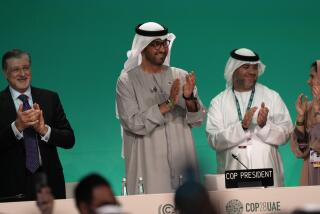90 Nations Agree on More Steps to Protect Ozone Layer : Environment: Measures include an earlier halt to use of damaging CFCs and eventual ban on substitute.
- Share via
WASHINGTON — Negotiators from about 90 countries agreed Wednesday on further steps to protect the Earth’s ozone layer, including speeding up a timetable for halting the use of a leading ozone-damaging chemical.
Government delegations meeting in Copenhagen agreed to eliminate the use of chemicals known as chlorofluorocarbons, or CFCs, four years earlier than planned and to move toward an eventual ban on similar chemicals used as substitutes in refrigerators and air-conditioning systems.
In completing work on updating a 1987 international accord on ozone protection, known as the Montreal Protocols, delegates also agreed that industrial countries will make an additional outlay of $340 million to $500 million to help developing countries move toward mass use of refrigeration without CFCs.
William K. Reilly, administrator of the U.S. Environmental Protection Agency, called the outcome “quite satisfactory,” although the United States got nowhere in efforts to have participants agree also to phase out the use of methyl bromide, one of the world’s most widely used pesticides, which also is linked to ozone damage.
“Overall,” Reilly said in a telephone interview from Copenhagen shortly after the negotiations were concluded, “it went better than I had expected that it would.”
But environmental groups expressed bitter disappointment at the failure to get an agreement on methyl bromide and to get a more ambitious timetable for ending the use of the coolant substitutes known as hydrochlorofluorocarbons, HCFCs.
The accelerated CFC phaseout and the other measures debated at the conference were largely inspired by evidence of ozone depletion, most seriously apparent in the annual appearance of the Antarctic ozone hole. Depletion of ozone in the Earth’s stratosphere is an environmental issue of global concern because it presents an increased threat of skin cancer caused by ultraviolet radiation.
After evidence of intensifying ozone depletion last winter, the Bush Administration unilaterally accelerated the U.S. timetable for phasing out CFCs by five years, from the year 2000 to 1995.
At the Copenhagen meeting, other signatories to the Montreal Protocols agreed to advance the timetable to 1996. They also agreed to cut HCFC production by 35% by 2004, by 65% by 2010, by 90% by 2015, by 99.5% by 2020 and to eliminate it entirely by 2030.
Continuing the production of a small amount for more than 30 years, Reilly said, is considered necessary to assure producers and consumers that coolants will continue to be available for special needs.
But environmentalists faulted negotiators for accepting weak consensus positions. “Governments are leaving Copenhagen without a commitment to phase out all known ozone-depleting chemicals,” said Liz Cook, ozone campaign director for Friends of the Earth. “The international community cannot honestly tell the public that it is doing everything possible to protect the Earth’s ozone layer.”
Friends of the Earth estimated that as much as 11 million tons of HCFCs will be produced before it is finally eliminated 38 years from now. Opposition to a more ambitious schedule was led by France.
The United States also had pressed for a larger commitment of funds to help developing nations adopt refrigeration and air conditioning without reliance on ozone-depleting chemicals.
Industrial nations that are party to the Montreal accords have agreed to provide $240 million for the fund between 1990 and 1993, and Reilly had said that $400 million to $600 million will be needed for the years 1994 to 1996. But European delegates balked, limiting their commitment to an additional $340 to $500 million.
More to Read
Sign up for Essential California
The most important California stories and recommendations in your inbox every morning.
You may occasionally receive promotional content from the Los Angeles Times.









